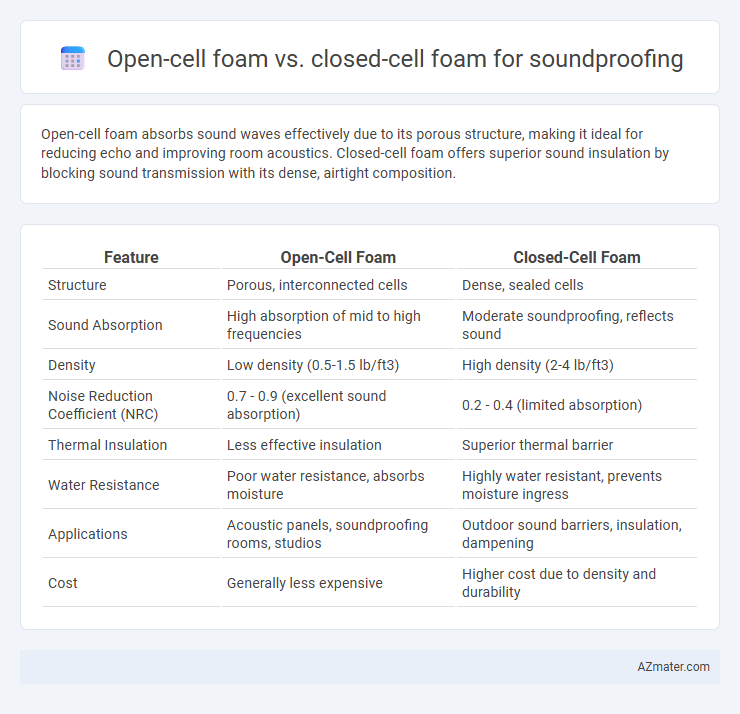Open-cell foam absorbs sound waves effectively due to its porous structure, making it ideal for reducing echo and improving room acoustics. Closed-cell foam offers superior sound insulation by blocking sound transmission with its dense, airtight composition.
Table of Comparison
| Feature | Open-Cell Foam | Closed-Cell Foam |
|---|---|---|
| Structure | Porous, interconnected cells | Dense, sealed cells |
| Sound Absorption | High absorption of mid to high frequencies | Moderate soundproofing, reflects sound |
| Density | Low density (0.5-1.5 lb/ft3) | High density (2-4 lb/ft3) |
| Noise Reduction Coefficient (NRC) | 0.7 - 0.9 (excellent sound absorption) | 0.2 - 0.4 (limited absorption) |
| Thermal Insulation | Less effective insulation | Superior thermal barrier |
| Water Resistance | Poor water resistance, absorbs moisture | Highly water resistant, prevents moisture ingress |
| Applications | Acoustic panels, soundproofing rooms, studios | Outdoor sound barriers, insulation, dampening |
| Cost | Generally less expensive | Higher cost due to density and durability |
Introduction to Open-cell and Closed-cell Foam
Open-cell foam features a porous structure that absorbs sound waves effectively, making it ideal for reducing echo and improving indoor acoustics. Closed-cell foam has a dense, airtight composition that provides superior sound blocking and moisture resistance, often used in environments requiring robust insulation. Both types offer unique acoustic benefits depending on the specific soundproofing needs and environmental conditions.
Key Differences Between Open-cell and Closed-cell Foam
Open-cell foam features a porous structure that absorbs sound waves efficiently, making it ideal for reducing mid to high-frequency noise, while closed-cell foam has a dense, airtight composition that blocks sound transmission and offers better insulation against low-frequency noise. Open-cell foam is softer, more flexible, and generally less expensive, but less moisture-resistant compared to the rigid, moisture-resistant, and durable nature of closed-cell foam. The choice between open-cell and closed-cell foam for soundproofing depends on specific acoustic needs, budget constraints, and environmental factors such as humidity.
Soundproofing Principles: Absorption vs. Isolation
Open-cell foam excels in sound absorption by trapping air within its porous structure, effectively reducing echo and reverberation inside rooms. Closed-cell foam provides superior sound isolation due to its dense, impermeable structure that blocks sound transmission between spaces. Selecting between open-cell and closed-cell foam depends on whether the goal is to absorb sound for improved acoustics or isolate sound to prevent noise leakage.
Acoustic Performance: Open-cell Foam
Open-cell foam exhibits superior sound absorption capabilities due to its porous structure that traps and dissipates airborne sound waves effectively. Its lightweight composition enhances acoustic performance by reducing sound reverberation and echo within rooms. Compared to closed-cell foam, open-cell foam provides better noise reduction for mid to high-frequency sounds, making it a preferred choice in soundproofing applications.
Acoustic Performance: Closed-cell Foam
Closed-cell foam offers superior soundproofing due to its dense, rigid structure that effectively blocks and reduces airborne noise transmission. Its high resistance to sound waves minimizes sound leakage and enhances acoustic isolation in various environments. This characteristic makes closed-cell foam ideal for applications requiring robust noise control, such as recording studios, industrial settings, and residential soundproofing.
Thermal Insulation and Additional Benefits
Open-cell foam offers superior thermal insulation due to its porous structure that traps air, making it ideal for reducing heat transfer in soundproofing applications. Closed-cell foam provides higher density and rigidity, enhancing soundproofing while offering excellent moisture resistance and structural support. Both types improve acoustic performance, but closed-cell foam adds extra durability and vapor barrier properties beneficial in humid environments.
Installation Process and Flexibility
Open-cell foam offers easier installation due to its lightweight and flexible nature, allowing it to conform to irregular surfaces and fill gaps effectively. Closed-cell foam, while denser and more rigid, requires precise cutting and fitting to ensure airtight soundproofing but provides superior moisture resistance during installation. The flexibility of open-cell foam supports faster application in complex spaces, whereas closed-cell foam's rigidity demands more careful handling but delivers enhanced durability.
Cost Comparison: Open-cell vs. Closed-cell Foam
Open-cell foam typically costs less per board foot compared to closed-cell foam, making it a more budget-friendly option for soundproofing projects. Closed-cell foam offers higher density and better soundproofing efficiency but comes with a significantly higher price due to its advanced insulation properties. Choosing between the two depends on balancing cost constraints with the desired level of sound attenuation and durability.
Best Applications for Each Foam Type
Open-cell foam, characterized by its porous structure, excels in absorbing mid to high-frequency sound waves, making it ideal for soundproofing in recording studios, home theaters, and office spaces where reducing echo and improving speech clarity are crucial. Closed-cell foam, denser and impermeable, provides superior sound blocking and moisture resistance, making it suitable for environments requiring both sound insulation and durability, such as industrial settings, wall cavities, and external building applications. Selecting the appropriate foam depends on balancing sound absorption needs with environmental factors and structural demands.
Choosing the Right Foam for Your Soundproofing Needs
Open-cell foam excels at absorbing mid to high-frequency sound waves due to its porous structure, making it ideal for reducing echo and improving room acoustics. Closed-cell foam provides superior sound insulation by blocking noise transmission with its dense, impermeable composition, which is effective for minimizing external noise infiltration. Selecting the right foam depends on whether your goal is to absorb sound within a space or to prevent sound from passing through walls or barriers.

Infographic: Open-cell foam vs Closed-cell foam for Soundproofing
 azmater.com
azmater.com